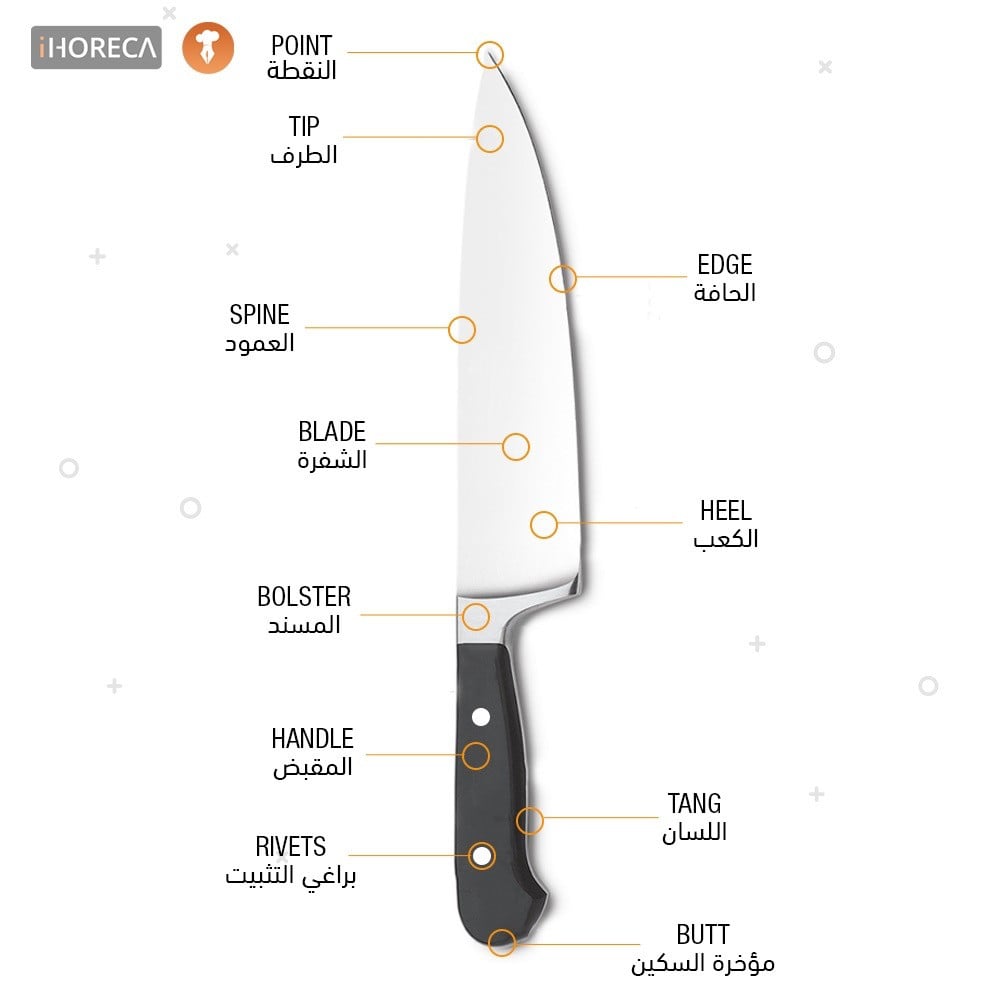Knives are one of the most important tools in any kitchen, if not the most important at all, especially when cooking a recipe, including the stages of preparing, preparing, designing, and serving dishes to customers, as chefs need a myriad of tools, and the knife comes at the forefront.
With the multiplicity and variety of types of knives in the field of preparing and providing food services, finding the best quality and suitable for your needs can be difficult. Without the correct knowledge of the world of knives , it becomes very easy to buy an insignificant set of them to satisfy your culinary desires in the kitchen, and this field is characterized by many names and terms. By which knives are defined, and that is why we have prepared this comprehensive guide from i Horeca to explain the types and purposes of using basic knives in different kitchens.
So let's start with the parts of the knife
If you want to buy a high-quality knife , understanding the basic parts of the knife and knowing their importance in designing the structure itself will help you complete this task with skill and success. In the following lines , we will explain each part of the knife and the function it performs; But you should know that this is only a comprehensive overview of design traits that most basic knives agree on, as many specialty knives may be made and offered with slightly different parts:
Point : It is the end of the blade, usually sharpened to a fine point, and can be used to pierce or slash the surface of food.
Blade : A blade is the name for the part of a knife used for cutting and is usually made of steel, although it may also be ceramic, titanium, or even iron.
Edge - “Edge” : It is the sharp part of the blade that is used for most cutting work, so you realize how sharp the knife is by how precise the edge is, and this depends on the quality of the knife and the number of times it is sharpened, and there are many different edges that we will discuss in the coming lines.
Tip - "Tip" : It is the front part of the knife edge, below the point, and the tip is the part of the blade that is usually used in fine cutting work.
Spine : The shaft is the sharp upper side of the blade opposite the cutting edge. The thickness of the shaft gives strength to the blade. As a general rule, the thicker the shaft, the stronger the blade. It is also important for providing kinetic balance to the knife while working.
Heel : The heel is the lower edge of the blade, further from the tip, next to the bolster, and is often the widest part of the blade. This part of the edge is most commonly used when a chef needs more force or pressure to cut through thicker foods.
The tongue - "Tang" : is the unserrated part that connects the edge of the blade to the handle. The tongue is an important part for the overall balance, stability and strength of the knife . The best knives are often thought of as having a "full tongue" which is defined as the knife that extends from the end of the blade to the rear; In some designs, the tongue is also used as a handle.
Handle - “Handle” or “Scale” : It is the part of the knife that the chef holds during use. It can be made of a number of materials and may be straight or designed in the shape of a finger and other convenient features that make it easier to carry. In some knife manufacturers, Dispensing with the handle and making a knife using a single piece of steel, so that the handle and tongue are one unit.
Bolster : The bolster is the raised space between the blade and the handle. It places a little space between the chef's hand and the blade to prevent fingers from slipping on the blade while cutting. It also provides extra weight to help hold the knife .
Handle Fasteners or Rivets : These are the screws or bolts that secure the handle parts to the tongue. Less expensive designs may forgo the screws and attach the handle to the tongue using adhesives.
Tail - "Butt" : the name of the part of the end of the handle, in the lower part of the knife

